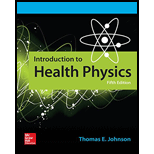
Concept explainers
(a)
With what velocity does the electron strike the positive plate if a cylindrical capacitor is made of two coaxial conductors—the outer one’s diameter is 20.2 mm and the inner one’s diameter is 0.2 mm; the inner conductor is 1000-V positive with respect to the outer conductor?
(a)
Explanation of Solution
Given info:.
Formula used:.
Kinetic energy
Potential energy
Calculation:.
We have,
Conclusion:.
Velocity
(b)
How long does it take the electron to travel the 1-cm distance? Compare the results to those of Problem 2.17.
(b)
Explanation of Solution
Given info:.
Formula used:.
Force
F = ma = qE
Calculation:.
We have force,
For a cylindrical capacitor,
We have,
This value is higher than the value obtained in Problem 2.17
Conclusion:.
Time taken
Want to see more full solutions like this?
Chapter 2 Solutions
Introduction To Health Physics
- Is my work good for 19 b)? I am not sure if it makes sense to do it this way please let me know :) the answer should be around 1.1 kNarrow_forwardHello, could you help me with this physics problem?arrow_forwardHi! Can someone answer activity 2 no. 2? Kindly include the given, the required, the formulas and the solution. Thanks!arrow_forward
- Albert Einstein is pondering how to write his (soonto-be-famous) equation. He knows that energy E is a function of mass m and the speed of light c, but he doesn't know the functional relationship (E = m2c? E = mc4?). Pretend that Albert knows nothing about dimensional analysis, but since you are taking a fluid mechanics class, you help Albert come up with his equation. Use the step-by-step method of repeating variables to generate a dimensionless relationship between these parameters, showing all of your work. Compare this to Einstein's famous equation—does dimensional analysis give you the correct form of the equation?arrow_forwardIf p/m is .9c,what is v in terms of c?arrow_forwardCan you explain this Q step by step?arrow_forward
- A man is driving his 4.5 m long automobile at 90 kph when the traffic signal in front of him changes to yellow. He is 55 m. from the intersection when he applies the brakes after 1.5 second reaction time. If the car can decelerates at a rate of 3.2 m/s2, at what velocity will he be moving when he reaches the intersection? If the yellow light is 5 seconds long, where will the man be when the light turns red? Assuming he will continue through at the speed found in part when the light changes to red. How long will the light have red when he clears the intersection having a width of 20m? Answer the problem and show complete solution pleasearrow_forwardA charged particle moves along a straight line in a uniform electric field E with a speed v. If the motion and the electric field are both in the x direction, (a) show that the magnitude of the acceleration of the charge q is given by a=dvdt=qEm(1v2c2)3/2 (b) Discuss the significance of the dependence of the acceleration on the speed. (c) If the particle starts from rest at x = 0 at t = 0, find the speed of the particle and its position after a time t has elapsed. Comment on the limiting values of v and x as t .arrow_forwardGo back to question 6 but this time assume uk=0.2. a) How much time elapses before the block reaches its maximum height up the plane? b) How much time elapses from the point it reaches maximum height up the plaane to the point where it was launched?arrow_forward
- There is approximately 1033 J of energy available from the fusion of hydrogen in the world’s oceans. (a) If 0.35 • 1033 J of this energy were utilized, what would be the decrease in the mass of the oceans? Express your answer in kilograms. (b) How great a volume of water does this correspond to in cubic meters?arrow_forwardConsider the equation for kinetic energy: KE = 1/2mv^2 = 1/2 * m * v^2. If I ask you to take the derivative of kinetic energy, you should ask "the derivative with respect to what?" a) Suppose mass m is constant. Compute the derivative of KE with respect to v, (d(KE)/dv). b) Who takes derivatives with respect to velocity? No one. Except you, just now. Sorry. The rate of change of energy with respect to time is more important: it is the Power. Now, consider velocity v to be a function of time, v(t). We will rewrite KE showing this time dependance: KE= 1/2 * m * v(t)^2. Show that (d(KE)/dt) = F(t)v(t). Hint: use Newton's second law, F = ma, to simplify. c) In the computation above, we assumed m was constant, and v was changing in time. Think of a physical situation in which both m and v are varying in time. d) Compute the Power when both mass and velocity are changing in time. (First rewrite KE(t) showing time dependence, then compute (d(KE)/dt).arrow_forwardShow (see also Problem 1–11) thatarrow_forward
 University Physics Volume 3PhysicsISBN:9781938168185Author:William Moebs, Jeff SannyPublisher:OpenStax
University Physics Volume 3PhysicsISBN:9781938168185Author:William Moebs, Jeff SannyPublisher:OpenStax Classical Dynamics of Particles and SystemsPhysicsISBN:9780534408961Author:Stephen T. Thornton, Jerry B. MarionPublisher:Cengage Learning
Classical Dynamics of Particles and SystemsPhysicsISBN:9780534408961Author:Stephen T. Thornton, Jerry B. MarionPublisher:Cengage Learning Modern PhysicsPhysicsISBN:9781111794378Author:Raymond A. Serway, Clement J. Moses, Curt A. MoyerPublisher:Cengage Learning
Modern PhysicsPhysicsISBN:9781111794378Author:Raymond A. Serway, Clement J. Moses, Curt A. MoyerPublisher:Cengage Learning


